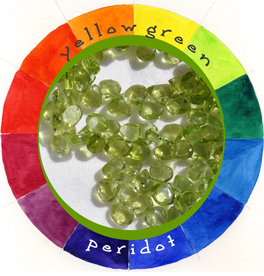y e l l o w g r e e n
Yellow-green may go by the names of chartreuse, lawn green, lime or granny smith apple green. It's a
tertiary color between yellow and veridian green. Like pale yellow, it connotates spring and new growth
but it doesn't have its own unique psychological properties; it shares with yellow and green. Its complementary
color (the opposite color on the color wheel) is red-purple, which explains why the combination of peridot
(yellow-green) and garnet (red-purple) can look so pleasing. Grossular garnet and green tourmaline are other
gemstones with terrific yellow-green color.
•• d e s i g n s f e a t u r i n g y e l l o w g r e e n
f u n f a c t s :

Peridot - also known as the mineral olivine - is a common yellow-green gemstone used for jewelry. Serpentine
is another common yellow-green stone, though it tends to be opaque and patterned. The mineral epidote provides the
olive green color in the granite unakite, and grossular garnet and Baltic
amber may also show darker hues of yellow-green. The bright apple green color of chalk "turquoise" is
achieved through stabilization of the soft chalk material and dye. However, it holds its color very well for
a dyed stone and looks more natural than most dyed stones.
Swarovski crystal colors mimic the mineral counterparts: "peridot" is a lighter, greener color and
"olivine" is a darker, more yellow color. Pearls and wood may be dyed yellow-green, but on pearls
in particular it tends to look sickly. Like peridot, yellow-green glass adds spring-like freshness to a
design at a more economical price.

 Peridot - also known as the mineral olivine - is a common yellow-green gemstone used for jewelry. Serpentine
is another common yellow-green stone, though it tends to be opaque and patterned. The mineral epidote provides the
olive green color in the granite unakite, and grossular garnet and Baltic
amber may also show darker hues of yellow-green. The bright apple green color of chalk "turquoise" is
achieved through stabilization of the soft chalk material and dye. However, it holds its color very well for
a dyed stone and looks more natural than most dyed stones.
Swarovski crystal colors mimic the mineral counterparts: "peridot" is a lighter, greener color and
"olivine" is a darker, more yellow color. Pearls and wood may be dyed yellow-green, but on pearls
in particular it tends to look sickly. Like peridot, yellow-green glass adds spring-like freshness to a
design at a more economical price.
Peridot - also known as the mineral olivine - is a common yellow-green gemstone used for jewelry. Serpentine
is another common yellow-green stone, though it tends to be opaque and patterned. The mineral epidote provides the
olive green color in the granite unakite, and grossular garnet and Baltic
amber may also show darker hues of yellow-green. The bright apple green color of chalk "turquoise" is
achieved through stabilization of the soft chalk material and dye. However, it holds its color very well for
a dyed stone and looks more natural than most dyed stones.
Swarovski crystal colors mimic the mineral counterparts: "peridot" is a lighter, greener color and
"olivine" is a darker, more yellow color. Pearls and wood may be dyed yellow-green, but on pearls
in particular it tends to look sickly. Like peridot, yellow-green glass adds spring-like freshness to a
design at a more economical price.